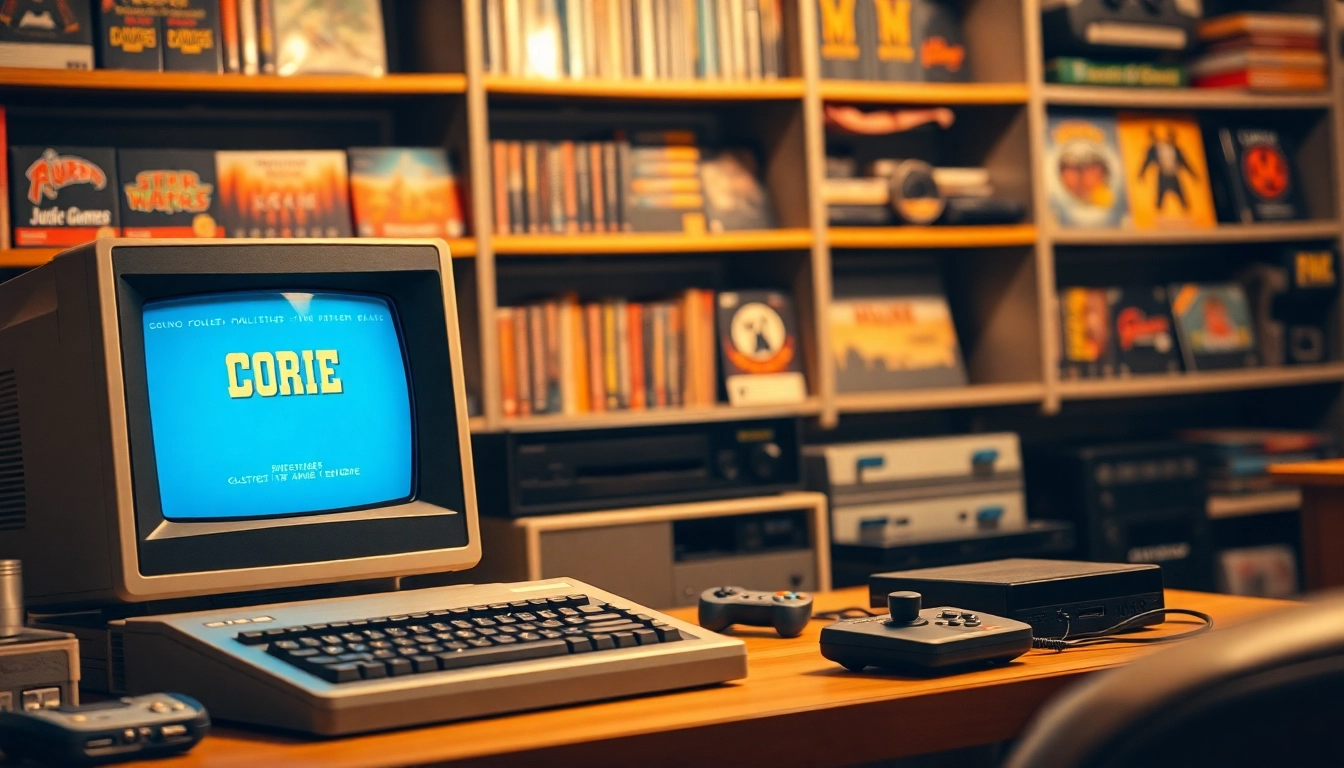
Introduction to Dune 2 Game
The dune 2 game is recognized as a cornerstone of real-time strategy (RTS) gaming, laying the foundations for future titles in the genre. Released in 1992, this remarkable game, officially titled “Dune II: The Building of a Dynasty,” introduced players to a richly envisioned universe inspired by Frank Herbert’s seminal science fiction series. Developed by Westwood Studios and published by Virgin Games, the game not only expanded upon the narrative landscape of Dune but also introduced groundbreaking gameplay mechanics that would shape RTS games for decades to come.
History and Development
The creation of Dune II was born from the desire to translate Herbert’s complex narrative into an interactive format. Westwood Studios faced the challenge of evolving established turn-based strategies into a fluid real-time experience. This endeavor necessitated innovative design choices, leading to features such as base construction, real-time resource management, and unit control, which have since become hallmarks of RTS games. Dune II’s development team included key figures like Brett Sperry, Aaron E. Powell, and Joseph Bostic, who conceptualized the game’s core mechanics and aesthetics, resulting in the engaging and dynamic gameplay experience it offers.
The game’s mechanics were revolutionary for its time, allowing players to control one of three factions—House Atreides, House Harkonnen, and House Ordos—each possessing unique units and strategies. Set against the backdrop of the desert planet Arrakis, players competed to harvest the valuable spice melange while engaging in warfare with rival factions, reflecting the political intrigue and conflict inherent in Herbert’s narrative.
Gameplay Mechanics Overview
Dune II is marked by its combination of strategic planning and action-packed gameplay. The core loop revolves around resource management, unit production, and tactical combat. Players must gather spice, which serves as the in-game currency, to build structures, train units, and advance their military objectives. The gameplay is structured around a series of missions, each presenting unique challenges and objectives, ranging from base defense to offensive assaults on enemy territory.
Impact on Real-Time Strategy Genre
The influence of Dune II is profound, often cited as the progenitor of the modern real-time strategy genre. Its innovative blend of resource management and combat set a template that would be emulated by countless games that followed, establishing conventions such as fog of war, build orders, and unit diversity. Dune II not only popularized real-time strategic gameplay but also demonstrated the potential for storytelling within the genre, allowing players to engage with a rich narrative while managing complex gameplay systems.
Gameplay Elements of Dune 2 Game
Units and Factions Explained
Players in Dune II select from three distinct factions, each with its unique strengths and weaknesses:
- House Atreides: Known for their balanced units and advanced technology, Atreides’s forces excel in defense and versatility, often leading to strategic play styles focused on adaptability.
- House Harkonnen: This faction emphasizes sheer firepower and aggression, boasting stronger units and the ability to construct units at a faster rate. Their playstyle tends to lean towards overwhelming force and rapid expansion.
- House Ordos: The enigmatic faction is characterized by its advanced technology and stealth units. Ordos strategies involve deception and unpredictability, utilizing hit-and-run tactics to undermine opponents.
The nuanced differences between the factions encourage players to explore various strategies, promoting replayability and a deeper understanding of the game’s mechanics.
Resource Management Strategies
Successful gameplay in Dune II relies heavily on effective resource management. Spice, the game’s primary resource, must be harvested efficiently to ensure sustainable development and military expansion. Players must construct refineries and harvesters strategically, often deploying units to defend these assets against enemy incursions. Timing is crucial; players must balance immediate military needs with long-term resource accumulation. Efficiently managing spice reserves while maintaining an aggressive defense posture can be the key to victory.
Mission Types and Objectives
Dune II features a variety of mission types that challenge players to adapt their strategic approaches. Missions can range from base construction and defense assignments to offensive campaigns targeting enemy strongholds. Each mission typically introduces new objectives, encouraging players to experiment with different tactics. For example, some missions may focus on stealth and subterfuge, while others necessitate brute force and extensive troop deployment. The diversity of objectives keeps gameplay engaging and requires players to think critically about their strategies.
Strategies for Success in Dune 2 Game
Early Game Tactics
The early game is pivotal in establishing a solid foundation for victory. Players should prioritize spice harvesting to secure funds for building units and research. Constructing multiple harvesters early on maximizes spice extraction, while sending units to scout enemy bases helps inform strategic decisions later in the game. Additionally, early defenses should be erected to protect critical resources from initial enemy assaults, creating a balance of offense and defense.
Building Your Base Effectively
A well-structured base is vital for efficient gameplay in Dune II. Players should consider the spatial placement of structures, ensuring that refineries are located close to spice fields and defensive structures are positioned to cover crucial entry points. Prioritizing the construction of defensive units while simultaneously expanding the base can deter enemy advances and allow for an effective counter-offensive strategy when necessary. A diverse array of buildings—including factories for unit production and barracks for training troops—further enhances operational capabilities.
Combat Strategies and Tips
Combat in Dune II demands a balanced approach that leverages the strengths of each faction. Players should focus on unit composition, integrating a mix of infantry, vehicles, and air support to create synergistic combat forces. Unit positioning during skirmishes greatly influences outcomes; flanking maneuvers and utilizing high ground can grant tactical advantages in battles. Additionally, players should continually adapt their strategies based on enemy behavior, using scouting information to counteract opponent tactics effectively.
Dune 2 Game Community and Modding
Fan Projects and Remakes
The enduring legacy of Dune II has inspired a thriving community of fans and modders dedicated to enhancing and remaking the original experience. Various fan projects aim to modernize the graphics and gameplay mechanics while preserving the game’s core experience. These efforts often lead to new interpretations of missions or balance adjustments for enhanced competitive play.
Engaging with the Community
Engagement with the Dune II community can significantly enhance the playing experience. Online forums and social media groups provide platforms for players to share strategies, discuss challenges, and collaborate on fan projects. Additionally, community events, including tournaments, can provide competitive opportunities and foster camaraderie among players, encouraging a shared love for this classic title.
Popular Mods and Customizations
Several noteworthy mods for Dune II have emerged, with names like “OpenDune” and others that serve as remakes, expanding the game’s lifespan and appeal. These mods often introduce new factions, altered mechanics, and enhanced graphics, allowing contemporary players to enjoy Dune II in a fresh context. Many mods are available for free and cater to different player preferences, whether one wants a nostalgic experience or a reimagined gameplay loop.
Legacy of Dune 2 Game
Influence on Modern Strategy Games
The legacy left by Dune II resonates profoundly in the realm of modern strategy games. Elements pioneered in Dune II, such as resource management and real-time combat, have become staples in numerous contemporary titles, influencing design choices and gameplay features across the genre. As players engage with newer titles, many will find echoes of Dune II’s mechanics, underscoring its lasting impact.
Continuing Popularity and Accessibility
Dune II has maintained its popularity over the decades, often being included in discussions around classic game franchises and ongoing nostalgia for vintage gaming. With the rise of platforms that support retro gaming, Dune II is now widely accessible to both new players and long-time fans looking to revisit the iconic game. Enhanced versions, remakes, and community support ensure its continued relevance in an ever-evolving gaming landscape.
Future of the Franchise
The future of the Dune franchise remains vibrant and promising. With ongoing interest in the Dune universe through films, shows, and new game titles, the potential for a revival of traditional gameplay in a modern context is strong. Players continue to express enthusiasm for developments that honor the original while exploring new creative avenues. Innovations in technology and storytelling mean that the essence of Dune II can continue to inspire future generations of gamers.





